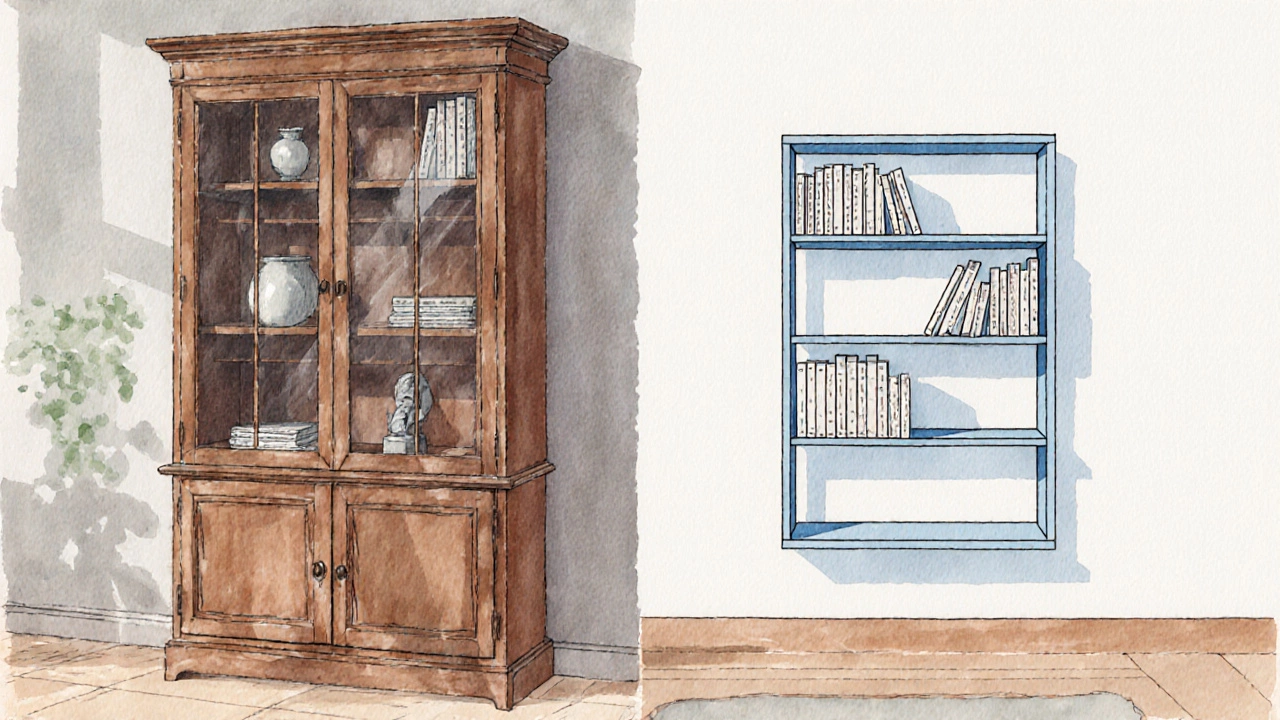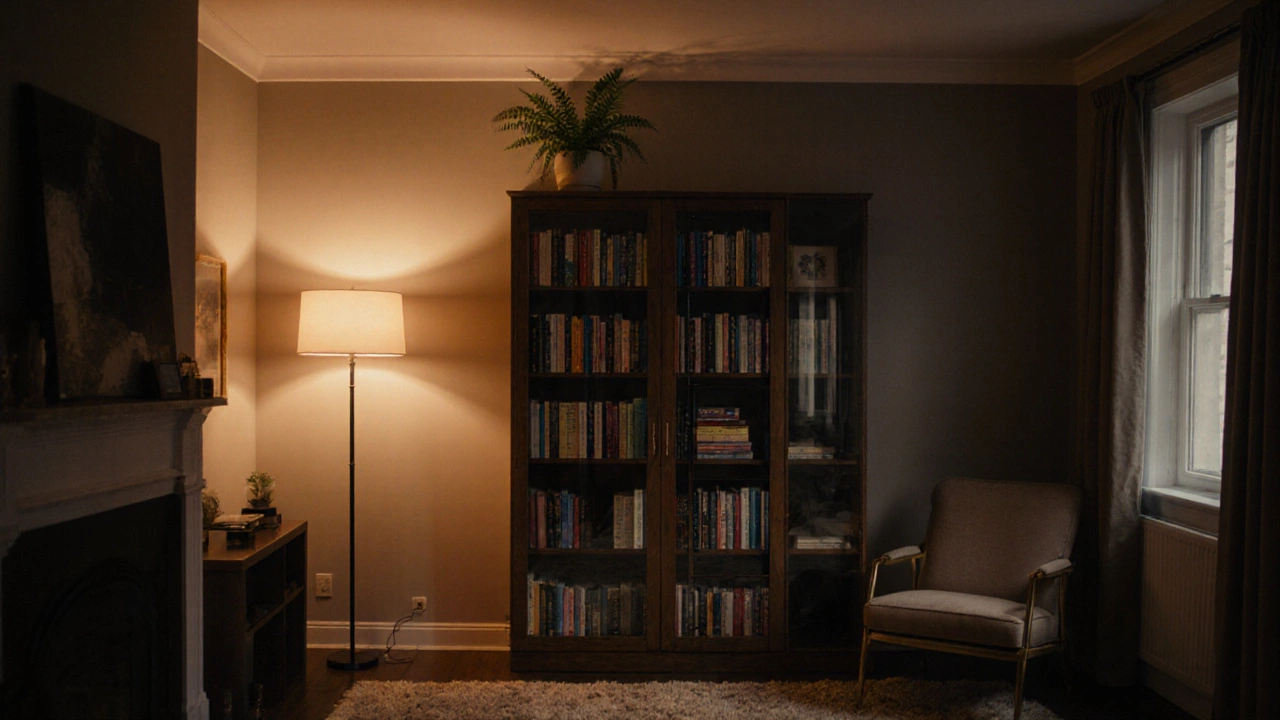Bookcase vs Bookshelf Selector
Select Your Requirements
Recommended Solution
Bookcase
Ideal for your space
Your measurements (width: , height: , depth: ) and usage needs match bookcase specifications. Bookcases offer more storage capacity and display options for your scenario.
Ever stared at a piece of furniture and wondered whether it’s a bookcase vs bookshelf dilemma? You’re not alone. Both help keep your reads tidy, but they serve different roles, look different, and fit distinct spaces. Below we untangle the confusion, show you how to pick the ideal piece, and give practical tips for styling and buying.
What is a Bookcase?
Bookcase is a tall, often freestanding piece of furniture designed with multiple vertical compartments for storing books, decorative items, or media. Classic bookcases feature a back panel, side panels, and a series of shelves that can be fixed or adjustable. They’re usually deeper than a typical bookshelf, allowing room for larger volumes and accessories like picture frames or plants.
Because of their generous depth, bookcases double as display units. They’re a staple in home libraries, living rooms, and office spaces where you want both storage and visual impact.
What is a Bookshelf?
Bookshelf is a narrower, often wall‑mounted or compact piece meant solely for arranging books in a linear fashion. Bookshelves focus on accessibility and a sleek profile, making them perfect for hallways, small apartments, or any spot where wall space is at a premium.
Most bookshelves are shallower-usually 6‑10 inches deep-so they hold standard paperback or hardcover sizes but struggle with oversized coffee‑table books.
Key Differences Between a Bookcase and a Bookshelf
- Depth: Bookcases typically range from 12‑18 inches, while bookshelves stay under 10 inches.
- Mounting: Bookcases are usually freestanding, whereas many bookshelves are wall‑mounted.
- Capacity: Bookcases can hold larger volumes, decorative objects, and even media equipment; bookshelves are optimized for books alone.
- Style: Bookcases often make a statement-think tall wooden units with glass doors-while bookshelves favor minimalism and function.
- Placement: Bookcases work well in living rooms, studies, and basements; bookshelves shine in entryways, bathrooms, or above a desk.

Choosing the Right Piece for Your Space
Start by measuring the wall or floor area you have. If you have a wide wall but limited depth, a wall‑mounted bookshelf can keep traffic flow open. If you need a focal point, a tall bookcase can anchor a room.
Consider the room’s purpose:
- Living room: A wooden bookcase with glass doors adds elegance and hides clutter.
- Home office: A metal‑frame bookcase offers industrial charm and can hold both books and filing cabinets.
- Small apartment: Floating shelves (a type of bookshelf) free up floor space while showcasing curated items.
Materials and Finishes
Different materials affect durability, look, and price. Here are the most common:
- Wood is the classic choice for both bookcases and bookshelves, offering warmth and a wide range of stains. Oak, walnut, and pine each bring a distinct grain and price point.
- Metal provides a modern, industrial vibe and can support heavier loads, especially in freestanding bookcases.
- Glass doors add a dust‑proof element and give a sleek, showroom feel, but they’re best paired with sturdy wooden frames.
- Composite MDF with veneer offers budget‑friendly looks, though it’s less robust for very heavy books.
Buying Tips and Price Ranges (2025)
- Set a budget: Expect $150‑$400 for a solid‑wood bookcase, $80‑$200 for a metal bookshelf, and $50‑$150 for MDF options.
- Check weight capacity: Look for a rating of at least 30lb per shelf if you plan to store large coffee‑table books.
- Measure height and width: Leave at least 2‑3inches of clearance around the piece for easy access.
- Read reviews: Pay attention to comments about assembly difficulty-some bookcases require a drill and extra hardware.
- Consider brand reputation: Companies like IKEA, Wayfair, and West Elm regularly update designs and offer warranty coverage.

Maintenance and Styling Ideas
Both bookcases and bookshelves benefit from regular dusting. Use a microfiber cloth and a gentle wood polish for wooden units, or a damp rag for metal frames.
Styling tricks:
- Arrange books by color for a visually striking gradient.
- Leave the top shelf empty for a decorative plant or a sculpture.
- Mix in baskets or boxes to hide smaller items like magazines.
Side‑by‑Side Comparison
| Feature | Bookcase | Bookshelf |
|---|---|---|
| Typical Depth | 12‑18 inches | 6‑10 inches |
| Mounting | Freestanding (can be anchored) | Wall‑mounted or compact freestanding |
| Load Capacity per Shelf | 30‑50lb | 15‑30lb |
| Best Use Cases | Living rooms, home libraries, offices | Hallways, small apartments, above desks |
| Common Materials | Solid wood, MDF with veneer, metal frames | Wood, metal, glass |
| Design Flexibility | Adjustable shelves, doors, glass panels | Fixed or adjustable shelves, minimal framing |
Frequently Asked Questions
Can I use a bookshelf as a TV stand?
A sturdy, wall‑mounted bookshelf made of metal or solid wood can hold a small flat‑screen TV, but you should check the weight rating. For larger TVs, a dedicated TV stand or a bookcase with reinforced shelving is safer.
Do bookcases need to be anchored to the wall?
Anchoring a tall bookcase prevents tip‑over accidents, especially in homes with children or pets. Most manufacturers include anchor brackets, and installing them takes only a few minutes.
Which is better for a minimalist aesthetic?
A floating bookshelf with clean lines and a light wood or metal finish enhances a minimalist look, while a bulkier bookcase can feel more traditional.
How much weight can a typical wall‑mounted bookshelf hold?
Most wall‑mounted shelves are rated for 20‑30lb per shelf. For heavier collections, choose a thicker board and use multiple anchors.
Is there a rule for arranging books on a bookcase?
No strict rule, but popular methods include sorting by genre, author, size, or color. Mixing decorative objects among books adds visual interest.



